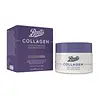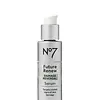What's inside
What's inside
 Key Ingredients
Key Ingredients

 Benefits
Benefits

 Concerns
Concerns

 Ingredients Side-by-side
Ingredients Side-by-side

Water
Skin ConditioningIsododecane
EmollientOctocrylene
UV AbsorberHydrogenated Tetradecenyl/Methylpentadecene
SolventEthylhexyl Salicylate
UV AbsorberC12-15 Alkyl Benzoate
AntimicrobialButyl Methoxydibenzoylmethane
UV AbsorberPropylene Glycol
HumectantBis-Ethylhexyloxyphenol Methoxyphenyl Triazine
Skin ConditioningMethylene Bis-Benzotriazolyl Tetramethylbutylphenol
UV FilterGlyceryl Stearate
EmollientEthylhexyl Triazone
UV AbsorberMethyl Methacrylate Crosspolymer
PEG-100 Stearate
Cetearyl Alcohol
EmollientPotassium Cetyl Phosphate
EmulsifyingSoluble Collagen
HumectantPhenoxyethanol
PreservativeBakuchiol
AntimicrobialAcrylates/C10-30 Alkyl Acrylate Crosspolymer
Emulsion StabilisingChlorphenesin
AntimicrobialDecyl Glucoside
CleansingSodium Hydroxide
BufferingDisodium EDTA
Isopentyldiol
HumectantParfum
MaskingDipropylene Glycol
HumectantGlycerin
HumectantXanthan Gum
EmulsifyingHexyl Cinnamal
PerfumingTrifolium Pratense Flower Extract
AstringentLinalool
PerfumingCoco-Glucoside
CleansingLimonene
PerfumingCaprylyl Glycol
EmollientAlcohol
AntimicrobialSodium Citrate
BufferingSodium Carrageenan
Emulsion StabilisingGlaucine
Skin ConditioningCitric Acid
BufferingMaris Sal
Skin ConditioningBiotin
AntiseborrhoeicWater, Isododecane, Octocrylene, Hydrogenated Tetradecenyl/Methylpentadecene, Ethylhexyl Salicylate, C12-15 Alkyl Benzoate, Butyl Methoxydibenzoylmethane, Propylene Glycol, Bis-Ethylhexyloxyphenol Methoxyphenyl Triazine, Methylene Bis-Benzotriazolyl Tetramethylbutylphenol, Glyceryl Stearate, Ethylhexyl Triazone, Methyl Methacrylate Crosspolymer, PEG-100 Stearate, Cetearyl Alcohol, Potassium Cetyl Phosphate, Soluble Collagen, Phenoxyethanol, Bakuchiol, Acrylates/C10-30 Alkyl Acrylate Crosspolymer, Chlorphenesin, Decyl Glucoside, Sodium Hydroxide, Disodium EDTA, Isopentyldiol, Parfum, Dipropylene Glycol, Glycerin, Xanthan Gum, Hexyl Cinnamal, Trifolium Pratense Flower Extract, Linalool, Coco-Glucoside, Limonene, Caprylyl Glycol, Alcohol, Sodium Citrate, Sodium Carrageenan, Glaucine, Citric Acid, Maris Sal, Biotin
Water
Skin ConditioningDimethicone
EmollientButylene Glycol
HumectantGlycerin
HumectantMethyl Gluceth-20
HumectantIsononyl Isononanoate
EmollientPolysilicone-11
Niacinamide
SmoothingPhenoxyethanol
PreservativeAcrylates/Beheneth-25 Methacrylate Copolymer
Tocopheryl Acetate
AntioxidantSilica
AbrasivePanthenol
Skin ConditioningPolysorbate 20
EmulsifyingCaprylyl Glycol
EmollientAmmonium Acryloyldimethyltaurate/Vp Copolymer
Potassium Hydroxide
BufferingXanthan Gum
EmulsifyingSodium Hyaluronate
HumectantHydrolyzed Rice Protein
Skin ConditioningDecyl Glucoside
CleansingPropylene Glycol
HumectantEthylhexylglycerin
Skin ConditioningAscorbyl Glucoside
AntioxidantPropanediol
SolventPentylene Glycol
Skin ConditioningTetrasodium EDTA
Hexylene Glycol
EmulsifyingT-Butyl Alcohol
PerfumingSodium Benzoate
MaskingMorus Alba Leaf Extract
Skin ConditioningPalmitoyl Tetrapeptide-94
Palmitoyl Tetrapeptide-95
Water, Dimethicone, Butylene Glycol, Glycerin, Methyl Gluceth-20, Isononyl Isononanoate, Polysilicone-11, Niacinamide, Phenoxyethanol, Acrylates/Beheneth-25 Methacrylate Copolymer, Tocopheryl Acetate, Silica, Panthenol, Polysorbate 20, Caprylyl Glycol, Ammonium Acryloyldimethyltaurate/Vp Copolymer, Potassium Hydroxide, Xanthan Gum, Sodium Hyaluronate, Hydrolyzed Rice Protein, Decyl Glucoside, Propylene Glycol, Ethylhexylglycerin, Ascorbyl Glucoside, Propanediol, Pentylene Glycol, Tetrasodium EDTA, Hexylene Glycol, T-Butyl Alcohol, Sodium Benzoate, Morus Alba Leaf Extract, Palmitoyl Tetrapeptide-94, Palmitoyl Tetrapeptide-95
 Reviews
Reviews

Ingredients Explained
These ingredients are found in both products.
Ingredients higher up in an ingredient list are typically present in a larger amount.
Caprylyl Glycol is a humectant and emollient, meaning it attracts and preserves moisture.
It is a common ingredient in many products, especially those designed to hydrate skin. The primary benefits are retaining moisture, skin softening, and promoting a healthy skin barrier.
Though Caprylyl Glycol is an alcohol derived from fatty acids, it is not the kind that can dry out skin.
This ingredient is also used as a preservative to extend the life of products. It has slight antimicrobial properties.
Learn more about Caprylyl GlycolDecyl Glucoside is a glucose-based surfactant and emulsion stabilizer. It is created by reacting glucose with the fatty acids from plants.
Surfactants help clean the skin by trapping oil, sebum, and dirt to be washed away. As an emulsion stabilizer, it stabilizes the ingredients in a product by preventing them from separating.
This ingredient is biodegradable and non-toxic. This ingredient is commonly found in baby shampoos.
Decyl Glucoside is sometimes used to stabilize the UV filter Tinosorb.
Learn more about Decyl GlucosideGlycerin is already naturally found in your skin. It helps moisturize and protect your skin.
A study from 2016 found glycerin to be more effective as a humectant than AHAs and hyaluronic acid.
As a humectant, it helps the skin stay hydrated by pulling moisture to your skin. The low molecular weight of glycerin allows it to pull moisture into the deeper layers of your skin.
Hydrated skin improves your skin barrier; Your skin barrier helps protect against irritants and bacteria.
Glycerin has also been found to have antimicrobial and antiviral properties. Due to these properties, glycerin is often used in wound and burn treatments.
In cosmetics, glycerin is usually derived from plants such as soybean or palm. However, it can also be sourced from animals, such as tallow or animal fat.
This ingredient is organic, colorless, odorless, and non-toxic.
Glycerin is the name for this ingredient in American English. British English uses Glycerol/Glycerine.
Learn more about GlycerinPhenoxyethanol is a preservative that has germicide, antimicrobial, and aromatic properties. Studies show that phenoxyethanol can prevent microbial growth. By itself, it has a scent that is similar to that of a rose.
It's often used in formulations along with Caprylyl Glycol to preserve the shelf life of products.
Propylene Glycol is an odorless, colorless liquid. As a humectant, it helps skin retain moisture. It also aids in delivering active ingredients.
Another role of this ingredient is preventing a product from melting or freezing. Propylene glycol also adds antimicrobrial properties to a product, elongating product lifespan.
This ingredient is considered an organic alcohol and commonly added into both cosmetics and foods.
Those with sensitive skin or conditions may develop a rash when using this ingredient.
Learn more about Propylene GlycolWater. It's the most common cosmetic ingredient of all. You'll usually see it at the top of ingredient lists, meaning that it makes up the largest part of the product.
So why is it so popular? Water most often acts as a solvent - this means that it helps dissolve other ingredients into the formulation.
You'll also recognize water as that liquid we all need to stay alive. If you see this, drink a glass of water. Stay hydrated!
Learn more about WaterXanthan gum is used as a stabilizer and thickener within cosmetic products. It helps give products a sticky, thick feeling - preventing them from being too runny.
On the technical side of things, xanthan gum is a polysaccharide - a combination consisting of multiple sugar molecules bonded together.
Xanthan gum is a pretty common and great ingredient. It is a natural, non-toxic, non-irritating ingredient that is also commonly used in food products.
Learn more about Xanthan Gum